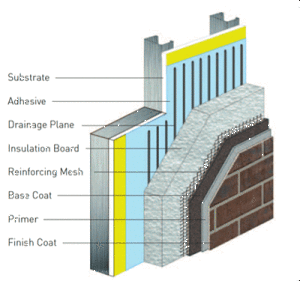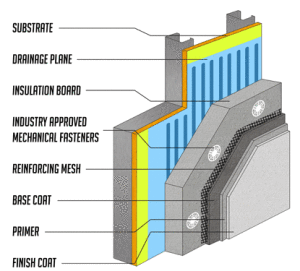EIFS are….According to the definitions of the International Building Code and ASTM International, an Exterior Insulation and Finish System (EIFS) is a nonload bearing, exterior wall cladding system that consists of an insulation board attached either adhesively or mechanically, or both, to the substrate; an integrally reinforced base coat; and a textured protective finish coat.
EIFS with Drainage, another EIFS system, is the predominate method of EIFS applied today. As the name implies, EIFS with Drainage provides a way for moisture that may accumulate in the wall cavity to evacuate.


EIFS were first introduced in the United States in the late 1960’s, and were first used on commercial buildings, and later on homes. EIFS typically consist of the following components:
- An optional water-resistive barrier (WRB) that covers the substrate
- A drainage plane between the WRB and the insulation board that is most commonly achieved with vertical ribbons of adhesive applied over the WRB
- Insulation board typically made of expanded polystyrene (EPS) which is secured with an adhesive or mechanically to the substrate
- Glass-fiber reinforcing mesh embedded in the base coat
- A water-resistant base coat that is applied on top of the insulation to serve as a weather barrier
- A finish coat that typically uses colorfast and crack-resistant acrylic co-polymer technology.
EIFS today are one of the most tested and well researched claddings in the construction industry. Research, conducted by the Oak Ridge National Laboratory and supported by the Department of Energy, has validated that EIFS are the “best performing cladding” in relation to thermal and moisture control when compared to brick, stucco, and cementitious fiberboard siding. In addition EIFS is in full compliance with modern building codes which emphasize energy conservation through the use of CI (continuous insulation) and a continuous air barrier. Both these components are built into today’s EIFS products to provide maximum energy savings, reduced environmental impact over the life of the structure, and improved IAQ, Indoor Air Quality. Along with these functional advantages come virtually unlimited color, texture, and decorative choices to enhance curb appeal and enjoyment of almost any home or structure.